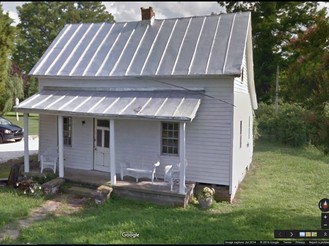 Teeny Blount House resembles Cotton Mill Village buildings
Teeny Blount House resembles Cotton Mill Village buildings In 2001, the Town of Edenton listed the Teeny Blount house as one of four contributing houses in the Edenton Historic District (Boundary Expansion) that was built by one prominent African American carpenter/builder during the Reconstruction era.
This designation was made in their boundary expansion application to the National Register of Historic Sites (NR) in 2001.
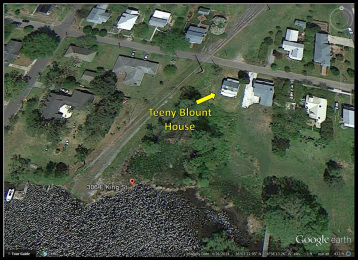 Teeny Blount House at Edenton Waterfront
Teeny Blount House at Edenton Waterfront This 1898 house was originally built in the “Black Heritage” neighborhood of Edenton, NC, however, the area is changing, becoming more integrated with affluent homeowners in recent years.
Descendants of Teeny Blount have been approached for many years about selling this waterfront property, and they have refused to give it up. This property is valued by the family, and they want to pass it on to the heirs of Teeny Blount.
Descendants of Teeny Blount have been approached for many years about selling this waterfront property, and they have refused to give it up. This property is valued by the family, and they want to pass it on to the heirs of Teeny Blount.
| Well, in 2015, the Town of Edenton cited the property as being a “public nuisance” and that the “nuisance is currently being abated.” [See photos] What is meant by public nuisance?
| |
Question: So, how is this house a public nuisance if it’s of historic value?
What is abatement?
Questions: The sign on the property stated, “This nuisance is currently being abated.”
What is the Town of Edenton planning to do with the Teeny Blount historic waterfront property?
a. Remove the house to another location?
b. Demolish it?
c. Oh, maybe the town is going to diminish the weathered condition of the house and restore it to its 1898 state?
What is abatement?
- A notice served on the owner(s) or occupier(s) of a property from which a private nuisance arises, warning them of the intention to enter on the land in order to abate the nuisance.
- Derived from Latin battere, "abatement" a common legal term meaning "the beating down, removal, or diminishment" of something.
Questions: The sign on the property stated, “This nuisance is currently being abated.”
What is the Town of Edenton planning to do with the Teeny Blount historic waterfront property?
a. Remove the house to another location?
b. Demolish it?
c. Oh, maybe the town is going to diminish the weathered condition of the house and restore it to its 1898 state?
Why is the Town of Edenton citing historic property as a nuisance and then moving to abate it?
| I’m a little confused and need clarity on the purpose of designating a property as historic with the National Register of Historic Sites and then citing it as a public nuisance for abatement. The first thing I want to know is what did the Town of Edenton actually say in their application to the National Register of Historic sites about the inclusion of the Teeny Blount House, and other African American properties that got them approved for historic status. This is what I know so far... Back in a 1987 CAMA Core Land Use Plan, the Town of Edenton indicated the necessity to preserve its historic and cultural heritage by nominating new historic structures for placement on the National Register of Historic Places, and to establish and expand the existing historic district (CAMA Core, 1987, pp. 36-37). Fourteen years later, on July 31, 2001, the Town of Edenton applied for the boundary expansion with the National Register of Historic Places. It was approved and entered on October 5, 2001. Their supporting statements to the National Register for including the Teeny Blount House and other African American properties in this boundary expansion was: a. “Property is associated with events that have made a significant contribution to the broad patterns of our history.” (NR 2001, p 3). | b. “The Edenton Historic District (Boundary Expansion) is eligible for nomination to the National Register of Historic Places under Criterion A in the area of Community Planning and Development because of its reflection of the growth and development of Edenton, and in the area of Ethnic Heritage: Black because it was home to one of the town's leading African American builders who most likely built not only his own residence but also a neighboring dwelling for Teeny Blount, another African American” (NR 2001, Sec 8, p 7). c. “Property embodies the distinctive characteristics of a type, period, or method of construction or represents the work of a master, or possesses high artistic values, or represents a significant and distinguishable entity whose components lack individual distinction” (NR 2001, p 3). d. The house was built within the period from 1883 to 1910 by African American Architect and Builder, John Tyler Page (NR 2001, p 3). e. The 1898 “Teeny Blount House at 306 East King Street (entry 6), is a traditional story-and-a-jump house typically erected by or for craftsmen and African American workers in Edenton” (NR 2001, Sec 7, p 1). If this property was so significant, why was it not included in the original 1973 National Register application? |
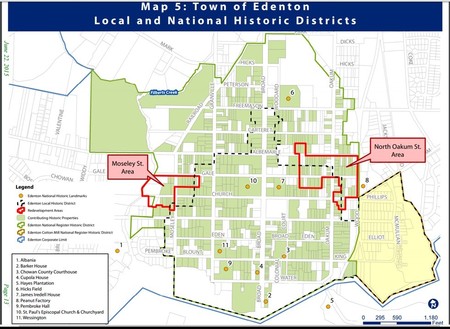 (Moseley St. Redevelopment Area, 2015, p. 13) Teeny Blount Property is on the map
(Moseley St. Redevelopment Area, 2015, p. 13) Teeny Blount Property is on the map In the 2001 National Register application, the Town of Edenton stated why African American architecture was not included in the original 1973 application.
This statement is amazing to read, and may shed some light on what is happening to the buildings in Edenton’s African American neighborhoods today.
“The nominated area was not included in the original Edenton Historic District for several reasons. The 1973 nomination focused almost entirely on the town's noted colonial and antebellum buildings.”
“Indeed, of thirteen pages covering the district's description and significance, only two are devoted to the 108 years after the Civil War. This slight is exaccerbated by the fact that early district nominations did not include an inventory list of every resource, and no such list was ever compiled retroactively for the district that would have provided information on buildings erected during the late nineteenth and early twentieth centuries. Thus, the nomination dealt exclusively with the buildings associated with the upper tier of wealthy or otherwise noted Edentonians, all of whom were white.”
“Even though African Americans have comprised more than half of the town's population since the mid eighteenth century and a small black residential area was included within the 1973 boundary, the town's and district's black residents are mentioned just twice in the nomination, each time as slaves toiling outside of town.”
“While these ommissions are regrettable, it must be noted that when the nomination was written in 1973, the town, state, and South were just climbing out of legal segregation. Subsequent re- examinations of the town's history and extensive research into the roles played by African American craftsmen during the eighteenth, nineteenth, and twentieth centuries have considerably expanded today's understanding of the town's development.”
“Furthermore, other areas immediately beyond the 1973 boundaries, including two late nineteenth-century African American neighborhoods, may be the subject of additional boundary expansion(s) pending further study.”
So, Edenton knew about the historic role African Americans had in its development. Why the secrecy, and when are they going to preserve and promote this legacy?
This statement is amazing to read, and may shed some light on what is happening to the buildings in Edenton’s African American neighborhoods today.
“The nominated area was not included in the original Edenton Historic District for several reasons. The 1973 nomination focused almost entirely on the town's noted colonial and antebellum buildings.”
“Indeed, of thirteen pages covering the district's description and significance, only two are devoted to the 108 years after the Civil War. This slight is exaccerbated by the fact that early district nominations did not include an inventory list of every resource, and no such list was ever compiled retroactively for the district that would have provided information on buildings erected during the late nineteenth and early twentieth centuries. Thus, the nomination dealt exclusively with the buildings associated with the upper tier of wealthy or otherwise noted Edentonians, all of whom were white.”
“Even though African Americans have comprised more than half of the town's population since the mid eighteenth century and a small black residential area was included within the 1973 boundary, the town's and district's black residents are mentioned just twice in the nomination, each time as slaves toiling outside of town.”
“While these ommissions are regrettable, it must be noted that when the nomination was written in 1973, the town, state, and South were just climbing out of legal segregation. Subsequent re- examinations of the town's history and extensive research into the roles played by African American craftsmen during the eighteenth, nineteenth, and twentieth centuries have considerably expanded today's understanding of the town's development.”
“Furthermore, other areas immediately beyond the 1973 boundaries, including two late nineteenth-century African American neighborhoods, may be the subject of additional boundary expansion(s) pending further study.”
So, Edenton knew about the historic role African Americans had in its development. Why the secrecy, and when are they going to preserve and promote this legacy?
| Well, in 2013, two late 19th century (1870-1900) African American neighborhoods [Moseley St and North Oakum St Redevelopments] became the subject of additional study by the Edenton Town Council. In May 13, 2014, the Edenton Town Council adopted a resolution to create the Town of Edenton Redevelopment Commission, then designated itself to have the powers, and to perform the duties and responsibilities of the commission. (N. Oakum St. Redevelopment, 2015, Appendix A). North Carolina State Statutes give commissions authority to acquire, prepare, sell and redevelop properties in areas that qualify as Redevelopment Zones (Edenton Neighborhood Redevelopment Plan). The Edenton Town council determined that 73% of buildings in the Moseley Street Redevelopment area, and 81% of the buildings in the North Oakum Street Redevelopment area were considered dilapidated and/or blighted and needed to be removed. | It's unfortunate that these two African American communities did not get the same redevelopment treatment as the dilapidated Cotton Mill village in 2007. (Same condition but a vastly different solution) In 2015, the Council moved swiftly to begin the process of eradicating the buildings from the town of Edenton (Moseley St. Redevelopment, 2015, p. 3). This is an extremely high number of buildings to remove from each neighborhood, especially since African Americans still live in many of the buildings and/or own the properties! Wow! I am shaking my head right now. It appears that this 27-year old strategy from 1987 is an action plan today. Too bad the plan is not in the best interest of the African American community. |
Questions In Need of Answers:
1. Weren’t these late 19th century buildings constructed by the early African American craftsmen mentioned in the 2001 National Register application? If so, are those structures still considered part of Edenton's rich history?
2. Since 2001, did anyone on the Edenton Town Council do or recommend an inventory of the dates of construction for these 19th century buildings as mentioned in their National Register application? If so, what were the findings of the inventory?
3. Why is Edenton repeating the same 1973 behaviors by preserving its antebellum, and post-Civil War era buildings for the upper tier of wealthy or noted White Edontonians, and not preserving the same buildings of its African American workforce? Didn't they mention this in the 2001 National Register application as one of their regrets from 1973?
4. Are local area citizens purchasing these targeted 19th century properties? If so, are any of these individuals directly or indirectly connected to the redevelopment project?
5. Which businesses or individuals benefit from the redevelopment of these historic African American neighborhoods?
The story of Edenton is incomplete without the history contained in the buildings that was and is inhabited by its African American residents. African Americans are the backbone and heart of Edenton's legacy, and they have stories to tell as well.
For some reason, Edenton prefers their silence. (Sounds like a preferred behavior from its Antebellum and Jim Crow days)

Using public nuisance or blighted area laws to remove over 75% of African American property from a town, raises a red flag in my mind.
March 20, 2015, I asked the following blog question: "Are Edenton’s African American Residents Facing Redevelopment or Expulsion in 2015"
We are close to answering this question.
Is anyone else hearing the alarms?
I feel like a voice crying in the wilderness…
Who will preserve
the heritage of our people...
What inheritance
will remain for our heirs...
When will our people...
ever receive justice
Selah...
References:
CAMA Core Land Use Plan, the Town of Edenton. 1987. Retrieved from:
https://www.gpo.gov/fdsys/pkg/CZIC-hd211-n8-e43-1987/html/CZIC-hd211-n8-e43-1987.htm
Edenton Historic District Boundary Increase 2 Additional Documentation. 2007. Retrieved from:
http://www.hpo.ncdcr.gov/nr/CO1185.pdf
Edenton Neighborhood Redevelop Plans. Retrieved from:
http://www.townofedenton.com/index.asp?SEC=08A66248-DB8F-4ABC-94E0-4B887AAD952E&Type=B_BASIC
Edenton Saves Dilapidated Cotton Mill 2007. Retrieved from:
http://www.iog.unc.edu/programs/cednc/stbi/cases/pdf/edenton.pdf
Moseley Street Redevelopment Plan Draft. 2014. Retrieved from:
http://www.townofedenton.com/vertical/sites/%7BF6F20A6A-6B1C-48BF-A15A-6193E41DA8DE%7D/uploads/Moseley_St_Redevelopment_Plan_6-22-2015.pdf
National Register of Historic Places Registration Form. 2001. Retrieved from:
http://www.hpo.ncdcr.gov/nr/CO0749.pdf
North Oakum Street Redevelopment Plan Draft. 2014. Retrieved from:
http://www.townofedenton.com/vertical/sites/%7BF6F20A6A-6B1C-48BF-A15A-6193E41DA8DE%7D/uploads/N_Oakum_St_Redevelopment_Plan_6-22-2015.pdf
Police Department Neighborhood Redevelopment Plan. 2013, Retrieved from:
http://www.townofedenton.com/vertical/sites/%7BAA7D8BD6-6E10-4D3C-9388-D6F02FC8CD39%7D/uploads/FINAL_Neighborhood_Plan_11-8-2013.pdf
Who will preserve
the heritage of our people...
What inheritance
will remain for our heirs...
When will our people...
ever receive justice
Selah...
References:
CAMA Core Land Use Plan, the Town of Edenton. 1987. Retrieved from:
https://www.gpo.gov/fdsys/pkg/CZIC-hd211-n8-e43-1987/html/CZIC-hd211-n8-e43-1987.htm
Edenton Historic District Boundary Increase 2 Additional Documentation. 2007. Retrieved from:
http://www.hpo.ncdcr.gov/nr/CO1185.pdf
Edenton Neighborhood Redevelop Plans. Retrieved from:
http://www.townofedenton.com/index.asp?SEC=08A66248-DB8F-4ABC-94E0-4B887AAD952E&Type=B_BASIC
Edenton Saves Dilapidated Cotton Mill 2007. Retrieved from:
http://www.iog.unc.edu/programs/cednc/stbi/cases/pdf/edenton.pdf
Moseley Street Redevelopment Plan Draft. 2014. Retrieved from:
http://www.townofedenton.com/vertical/sites/%7BF6F20A6A-6B1C-48BF-A15A-6193E41DA8DE%7D/uploads/Moseley_St_Redevelopment_Plan_6-22-2015.pdf
National Register of Historic Places Registration Form. 2001. Retrieved from:
http://www.hpo.ncdcr.gov/nr/CO0749.pdf
North Oakum Street Redevelopment Plan Draft. 2014. Retrieved from:
http://www.townofedenton.com/vertical/sites/%7BF6F20A6A-6B1C-48BF-A15A-6193E41DA8DE%7D/uploads/N_Oakum_St_Redevelopment_Plan_6-22-2015.pdf
Police Department Neighborhood Redevelopment Plan. 2013, Retrieved from:
http://www.townofedenton.com/vertical/sites/%7BAA7D8BD6-6E10-4D3C-9388-D6F02FC8CD39%7D/uploads/FINAL_Neighborhood_Plan_11-8-2013.pdf

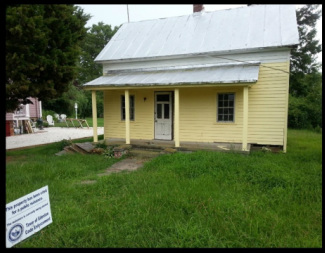
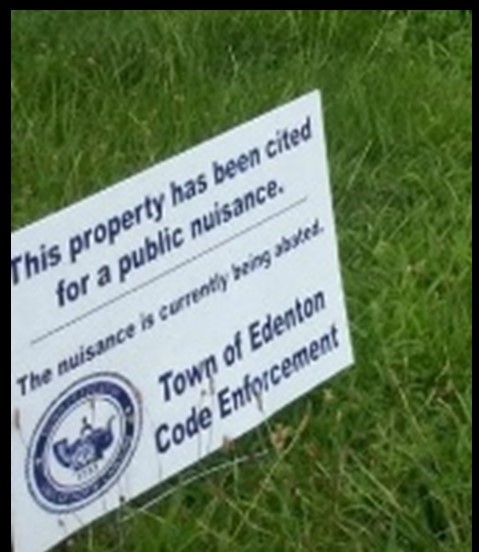


 RSS Feed
RSS Feed